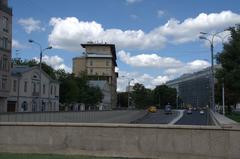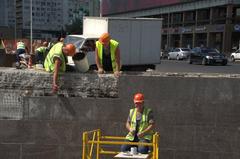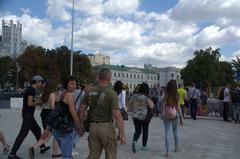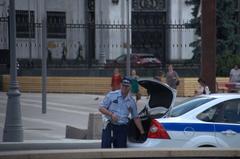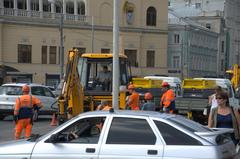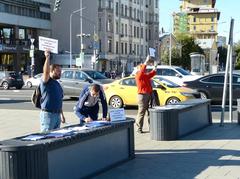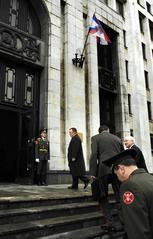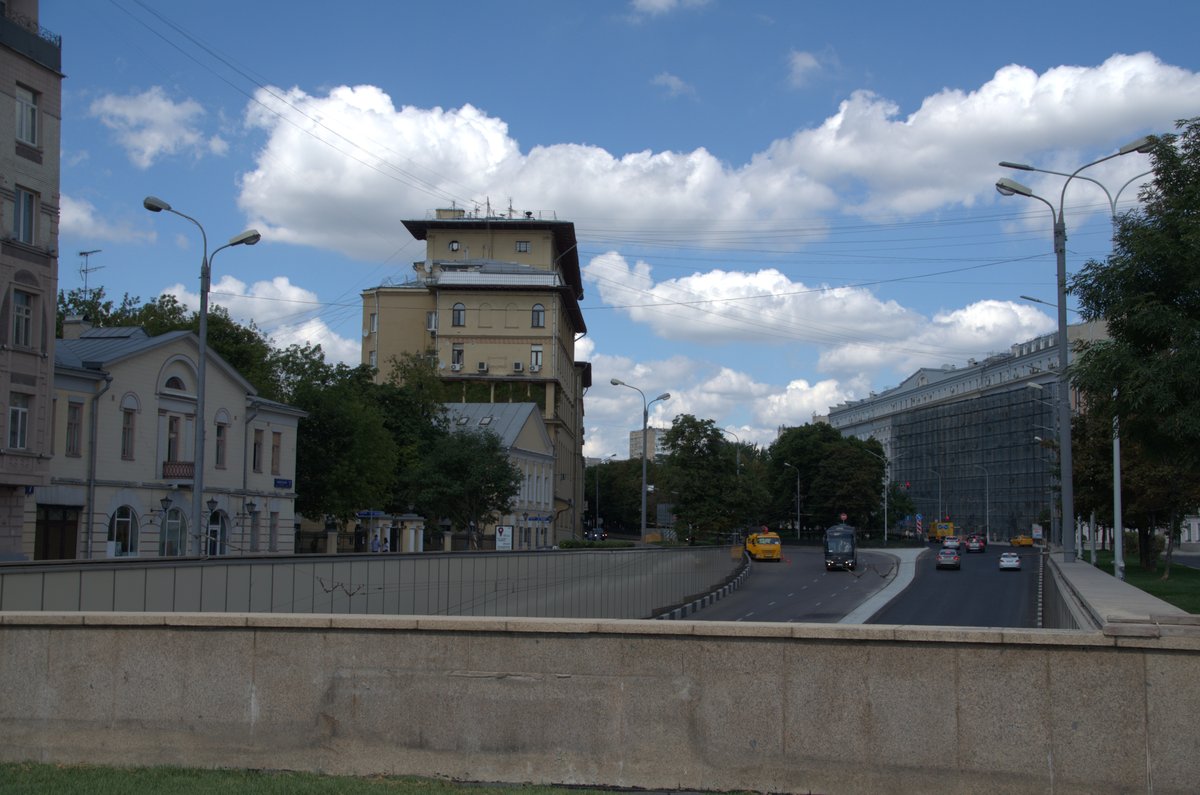
Arbatskaya Square Moscow: Visiting Hours, Tickets, and Guide to Historical Sites
Date: 14/06/2025
Introduction: Arbatskaya Square’s History and Cultural Significance
Arbatskaya Square, nestled in the heart of Moscow, is more than a bustling crossroads—it’s a living showcase of the city’s multifaceted heritage. Once the starting point of a 15th-century trade route to the west, the square has mirrored Moscow’s transformation from medieval fortifications to a vibrant urban hub. Its evolution has seen it become a prestigious residential neighborhood in the Imperial era, a site of Soviet modernization, and, more recently, a cultural landmark at the gateway to the renowned pedestrian Arbat Street (Express to Russia; Siberian Falcon).
Today, Arbatskaya Square’s eclectic architecture—ranging from Stalinist skyscrapers to restored mansions—reflects Moscow’s ongoing dialogue between history and innovation. This guide provides a detailed overview of the square’s storied past, practical visitor information, highlights of nearby attractions, and tips for an enriching experience in one of Moscow’s most iconic locales (GPSmyCity; Touropia).
Historical Overview
Origins and Early Development
Arbatskaya Square’s roots trace back to the 15th century, when it emerged as the starting point of a vital trade route westward to Mozhaisk and Smolensk. The area quickly developed into a hub for palace artisans and craftsmen, with the name “Arbat” possibly derived from the Arabic “rabad” (suburb) or the Turkic “arba” (cart) (Express to Russia).
Role in Moscow’s Fortifications
Strategically positioned at the Arbat Gates of the White City fortress in the late 16th century, Arbatskaya Square served as a threshold between the city’s fortified core and its growing suburbs. The area became a densely populated settlement known as Skorodom, housing artisans and soldiers, and later saw dramatic change due to the abolition of the Streltsy garrisons and devastating fires in 1736 and 1812 (Express to Russia).
Imperial Transformation
The aftermath of the great fires led to a new era for Arbatskaya Square, as Moscow’s nobility established grand mansions and lush gardens in the district. By the late 19th century, it had become a center for the city’s artistic and intellectual elite, with legendary establishments like the Praga restaurant serving as social landmarks (Express to Russia).
Soviet Modernization and Urban Renewal
The 20th century brought electrified trams (in 1904), major infrastructure changes, and the opening of the Arbatskaya Metro station in 1935 (Siberian Falcon). Soviet-era urban renewal saw the construction of functionalist apartment blocks, demolition of several historic churches, and the rise of government buildings such as the Ministry of Foreign Affairs.
Pedestrianization and Cultural Renaissance
In the 1980s, Arbat Street became the Soviet Union’s first pedestrian zone. The transformation included restoration of historic facades and the installation of unique street lanterns, establishing the area as a magnet for artists, musicians, and youth culture—most famously encapsulated in the graffiti-laden Tsoi Wall (Siberian Falcon).
Key Landmarks and Attractions
Architectural Highlights
- Ministry of Foreign Affairs: One of Stalin’s “Seven Sisters,” this neo-Gothic skyscraper dominates the western edge of the square.
- Classical Mansions: Restored buildings representing the district’s aristocratic past.
- Praga Restaurant: A historic dining venue frequented by literary icons.
Cultural Monuments
- Pushkin Memorial Apartment Museum: Experience the preserved home of Alexander Pushkin, Russia’s national poet (official museum website).
- Pushkin and Natalia Goncharova Monument: A bronze statue marking the entrance to Arbat Street.
- Bulat Okudzhava Monument: Honoring the famed Soviet songwriter and bard.
Artistic and Social Landmarks
- Tsoi Wall: A living street art tribute to Viktor Tsoi, symbolizing the district’s rebellious spirit.
- Princess Turandot Fountain-Monument: A whimsical installation near the Vakhtangov Theatre.
- Vakhtangov Theatre: A leading Moscow drama venue with guided tours and performances.
Visitor Information
Opening Hours and Ticket Information
- Arbatskaya Square: Open 24/7, no entrance fee.
- Pushkin Memorial Apartment Museum: Tuesday–Sunday, 11:00 AM–6:00 PM; closed Mondays. Adult tickets ~300 RUB.
- Vakhtangov Theatre: Showtimes and ticket prices vary by performance.
- Outdoor Monuments and Installations: Accessible at all hours.
It is recommended to check official websites or tourism portals for the latest schedules and ticket information, especially during holidays.
Accessibility
- Wheelchair and Stroller Access: Flat, wide walkways and step-free metro access make the area accessible.
- Metro Access: Served by two Arbatskaya stations (Lines 3 and 4), both featuring escalators and elevators.
Getting There
- Metro: Arbatskaya stations (Arbatsko-Pokrovskaya and Filyovskaya Lines) are directly beneath the square.
- Bus/Tram: Several lines serve the area, though traffic can be heavy.
- Taxi: Yandex GO app is recommended for reliable, English-friendly service.
- On Foot: The square is just 800 meters from the Kremlin and Red Square, making it ideal for pedestrians (DK Eyewitness).
Best Times to Visit
Visit in spring and autumn for optimal weather and manageable crowds. Weekday mornings and evenings offer a quieter experience, while weekends are lively with street performances.
Amenities and Practical Tips
- Restrooms: Available in metro stations and nearby cafes (small fee may apply).
- Free Wi-Fi: Available in metro stations and many local cafes.
- Dining: Options range from fast food to historic Russian eateries; try local dishes like borscht and blini.
- Shopping: Arbat Street is renowned for souvenirs—matryoshka dolls, amber jewelry, and Soviet memorabilia (PlanetWare).
- Language: English is widely spoken in tourist areas; signage is bilingual.
- Currency: Russian ruble (RUB). Cards are widely accepted, but carry cash for small purchases.
- Dress Code: Comfortable attire and shoes recommended.
- Safety: The area is well-patrolled; usual precautions apply (Express to Russia; Owl Over the World).
- Emergency Number: Dial 112 for emergencies.
Navigating the Area
Following a 2016 redevelopment, Arbatskaya Square boasts pedestrian-friendly granite walkways, benches, and modern lighting. English and Russian signage, as well as flat terrain, ensure easy navigation for all visitors (travelwaiting.com).
Nearby Attractions
- Arbat Street: A kilometer-long pedestrian boulevard filled with shops, cafes, and historic architecture (Wikipedia).
- Red Square and the Kremlin: UNESCO sites a short walk east (PlanetWare).
- Pushkin Museum of Fine Arts: Celebrated for its art collections.
- Khudozhestvenny Cinema: Historic cinema overlooking the square.
- Cathedral of Christ the Savior: Notable for its golden domes (Touropia).
Guided Tours and Experiences
Numerous local agencies offer guided walking tours of Arbatskaya Square and the Arbat district, often focusing on history, architecture, and hidden gems. Tours are available in multiple languages and can be booked online or on-site (GPSmyCity). Self-guided options are also available via apps such as GPSmyCity.
Events and Seasonal Highlights
Arbatskaya Square and Arbat Street host festive events, live performances, and cultural celebrations throughout the year. Winter brings illuminated displays and a magical snowy atmosphere, while summer and autumn are popular for street festivals (Touropia).
Frequently Asked Questions (FAQ)
Q: Is there an entrance fee to Arbatskaya Square?
A: No, the square is free and open 24/7.
Q: Are museums and theatres around the square ticketed?
A: Yes, check official sites for opening hours and ticket prices.
Q: Is the area wheelchair accessible?
A: Yes; walkways are flat and metro access is step-free, though some side streets have cobblestones.
Q: What’s the best way to get to the square?
A: Metro is fastest (Arbatskaya stations, Lines 3 and 4); taxis and walking are also convenient.
Q: When is the best time to visit?
A: Weekdays in spring or autumn for pleasant weather and fewer crowds.
Visual Resources
Essential Apps and Resources
- Yandex Metro: For navigation.
- Yandex GO: For taxis.
- Yandex Translate: For language support.
- GPSmyCity: Self-guided tours (GPSmyCity).
Summary and Recommendations
Arbatskaya Square is a microcosm of Moscow’s layered past and lively present. Its 24/7 accessibility, proximity to major landmarks, and rich tapestry of architecture and culture make it an essential stop for any visitor. Plan your trip for spring or autumn weekdays, and use the metro for convenience. For an enhanced experience, download the Audiala app for real-time updates and guided walking routes.
Further Reading and Official Resources
- Express to Russia, Historical Guide to Arbatskaya Square
- Siberian Falcon, Arbat Street Moscow Overview
- GPSmyCity, Arbatskaya Square and Arbat Street Walking Tour
- Touropia, Tourist Attractions in Moscow
- PlanetWare, Top Rated Tourist Attractions in Moscow
- Owl Over the World, Moscow Travel Tips
- DK Eyewitness Moscow
- Wikipedia, Arbatskaya Square
- Wikipedia, Arbat Street
- Pushkin House-Museum Official Site
